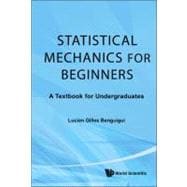
What is included with this book?
| Dedication | p. v |
| Preface | p. vii |
| List of Figures | p. xiii |
| Physical Constants | p. xv |
| Introduction | p. 1 |
| Fundamentals | p. 7 |
| The Closed System or the Microcanonical Ensemble | p. 9 |
| The Microcanonical Ensemble | p. 9 |
| Properties of the Entropy | p. 12 |
| An Example | p. 17 |
| The System in Thermal Contact with a Reservoir: The Canonical and Grand Canonical Ensembles | p. 22 |
| The Canonical Ensemble | p. 23 |
| The partition function | p. 23 |
| Energy, entropy and thermodynamic potential | p. 26 |
| A two-level system | p. 29 |
| The ideal gas; equipartition of energy in classical mechanics | p. 30 |
| The Grand Canonical Ensemble | p. 33 |
| The grand partition function | p. 34 |
| The number of particles, energy, entropy and the grand potential | p. 36 |
| An example | p. 38 |
| Summary | p. 41 |
| Fluctuations | p. 42 |
| Final remark | p. 43 |
| Quantum Statistics | p. 44 |
| The Partition Function and the Free Energy | p. 45 |
| For variable N and for fermions | p. 46 |
| For variable N and for bosons | p. 46 |
| For fixed N, and for both fermions and bosons | p. 47 |
| The Energy and the Entropy | p. 49 |
| The Classical Ideal Gas: Maxwell-Boltzmann Statistics | p. 50 |
| Qualitative Behavior of the Chemical Potential and the Derivation of (∂¿/∂T)V,N <0 | p. 53 |
| Bosons | p. 53 |
| Fermions | p. 54 |
| The Density of States | p. 55 |
| The Wave Vector | p. 56 |
| The Density of States | p. 57 |
| The Monatomic Ideal Gas | p. 58 |
| The partition function | p. 58 |
| The internal energy, entropy and equation of state | p. 59 |
| The classical limit | p. 60 |
| Some Problems | p. 61 |
| The Quantum Harmonic Oscillator | p. 61 |
| Low temperature limit | p. 64 |
| High temperature limit | p. 65 |
| The Polyatomic Ideal Gas | p. 66 |
| Bosons and Fermions in a Two-Level System | p. 68 |
| The particles are bosons | p. 69 |
| The particles are fermions | p. 72 |
| Classical particles | p. 73 |
| The Magnetic Chain | p. 75 |
| Applications | p. 79 |
| The Gas of Photons: The Black Body Radiation | p. 81 |
| The Energy and the Energy Spectrum | p. 83 |
| The Free Energy and the Entropy | p. 87 |
| The relation with the wave picture | p. 88 |
| Light Emission and Absorption of Solids; Kirchhoff's Law | p. 88 |
| The Black Body Emission | p. 90 |
| The Properties of Photon Gas are Independent of the Shape and the Material of the Cavity | p. 90 |
| Atomic Vibration in Solids: Phonons | p. 92 |
| Atomic Vibration in Solids | p. 92 |
| The Properties of Phonons | p. 97 |
| The Low Temperature Case | p. 97 |
| The High Temperature Case | p. 99 |
| The Debye Formula | p. 100 |
| Resolution of the Differential Equation (7.1) by Means of Trigonometric Functions | p. 104 |
| Derivation of the Expression (7.30) Giving Cv in the Debye Model | p. 105 |
| The Boson Gas at Low Temperature: The Bose-Einstein Condensation | p. 107 |
| The Chemical Potential | p. 108 |
| The Energy, Specific Heat, Free Energy and Entropy | p. 112 |
| Experimental Verfication | p. 114 |
| The Gas of Fermions: Electrons in Metals and in Semiconductors | p. 116 |
| Free Electrons in a Box | p. 116 |
| The Fermi-Dirac function | p. 116 |
| The chemical potential or the Fermi level | p. 120 |
| The energy | p. 123 |
| The specific heat | p. 127 |
| Applications to metals | p. 129 |
| Electrons in Semiconductors | p. 131 |
| A History of Statistical Mechanics | p. 136 |
| Thermodynamics and Statistical Mechanics Before Maxwell and Bolztmann | p. 136 |
| The Kinetic Theory of Maxwell | p. 138 |
| Boltzmann and Irreversibility | p. 139 |
| Gibbs, the Father of Statistical Mechanics | p. 141 |
| Planck and Einstein: Quantum Theory and Statistics | p. 142 |
| The Method of Bose and the Bose-Einstein Condensation | p. 145 |
| The Principle of Pauli and the Statistics of Fermi and Dirac | p. 146 |
| Modern Developments | p. 147 |
| Exercises | p. 148 |
| Index | p. 161 |
| Table of Contents provided by Ingram. All Rights Reserved. |
The New copy of this book will include any supplemental materials advertised. Please check the title of the book to determine if it should include any access cards, study guides, lab manuals, CDs, etc.
The Used, Rental and eBook copies of this book are not guaranteed to include any supplemental materials. Typically, only the book itself is included. This is true even if the title states it includes any access cards, study guides, lab manuals, CDs, etc.